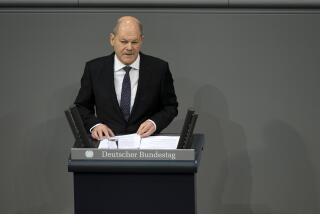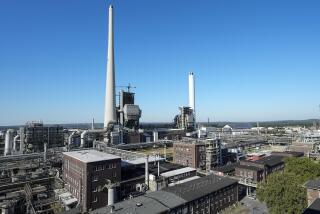International Business / Executive Travel: SPOTLIGHT ON GERMANY : The German Economy
- Share via
In the midst of western Europe’s worst recession since the end of World War II, Germany is struggling with slack demand at home and abroad, high labor costs and the huge expense of unification with the former East Germany.
The Economy
Last year, the western German economy shrunk 1.9 percent, the largest drop in the postwar era. Nationwide, gross national product fell 1.3 percent from 1992 to 1993. Unemployment has ballooned to a postwar high of 10.5%. Despite calls to help Europe’s ailing economies, Germany’s influential central bank has pursued a tight money policy and has cautiously reduced interest rates to avoid a surge in inflation.
East-West Union
The unification of West Germany (Federal Republic of Germany) and East Germany (German Democratic Republic) in October 1990 joined one of the world’s richest countries with one of Europe’s poorest. Today, western Germany is still far more prosperous, with eastern Germany accounting for only about 7 percent of the total German economy. Since unification, eastern Germany has survived mainly on subsidies from the west--totaling nearly $100 billion a year and more than 7,000 people migrate from east to west every month.
Labor Force
German workers are among the world’s most literate and highly skilled. The literacy rate is 99 percent. German law requires 12 years of compulsory schooling beginning at age 6. One third of German teens spend high school in vocational training while working part time as apprentices.
Labor Costs
German wages have been rising faster than those of other major industrial nations and nearly twice as fast as Germany’s own industrial output. From 1985 to 1993, unionized workers’ real hourly wages grew 23%, but growth in output grew 12%. In comparison, real wages in the United States fell 8.5% for the period.
Trade
France is Germany’s biggest trading partner, accounting for 12 percent of imports and 13 percent of exports in 1991. More than half of all German imports and exports are traded with fellow members of the European Union. Germany’s principal imports and exports are machinery and transport equipment, manufactured goods and chemical products.
Manufacturing
Nearly one in three Germans is employed in manufacturing, the country’s most important sector. Germany is the world’s third-largest car exporter, behind Japan and the United States. The country also produces transport equipment, non-electrical machinery, metals and metal products and chemical products. Total exports from Germany totaled more than $400 billion in 1992.
Natural Resources
Germany has substantial deposits of hard coal, lignite, a low-grade soft brown coal, and salt. Copper, tin and nickel ores and potash salts are also mined. Western Germany mined 178 million metric tons of coal and 3.4 million metric tons of crude petroleum in 1991. Mining employs about 1 percent of the German work force and accounted for about 3 percent of GDP in 1991.
More to Read
Inside the business of entertainment
The Wide Shot brings you news, analysis and insights on everything from streaming wars to production — and what it all means for the future.
You may occasionally receive promotional content from the Los Angeles Times.










